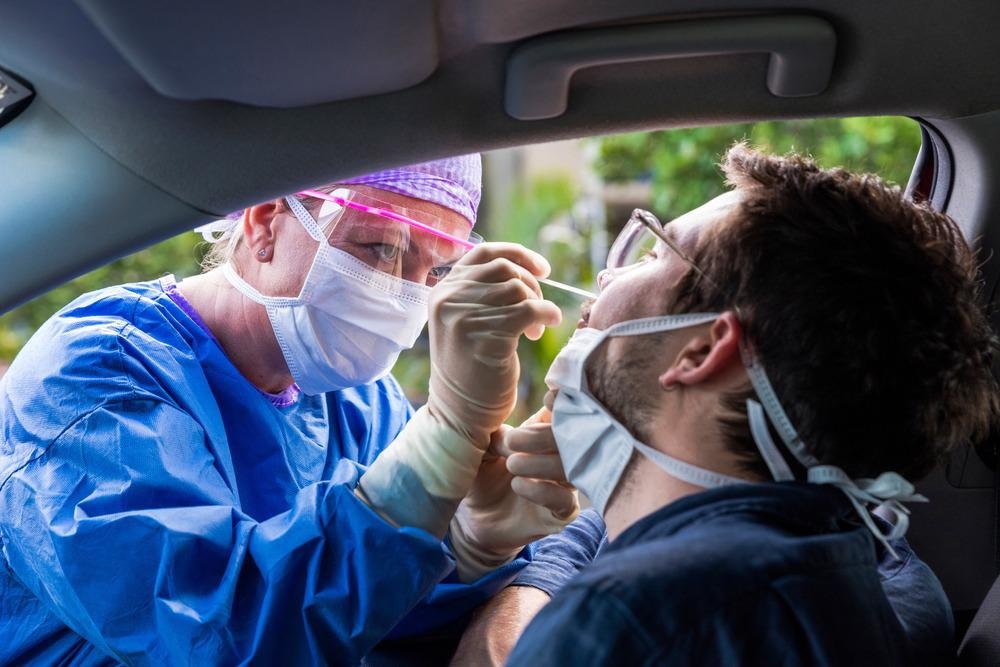A new method to detect COVID-19 illness and related health concerns using biosensors as nanoanalytical instruments has been published in Sensors Journal. Advancement in the health industry afforded by nanotechnology has assisted in disease and epidemic monitoring at a preliminary phase.

Study: Biosensors as Nano-Analytical Tools for COVID-19 Detection. Image Credit: zstock/Shutterstock.com
A SARS-CoV-2 infection should be validated by finding a unique RNA pattern, according to WHO standards. Scientists are working hard to improve various diagnostic approaches to overcome multiple issues and constraints associated with PCR-based technologies to establish low-cost, accurate, and quick detection systems for SARS-CoV-2.
Nano-enabled biosensors are suitable for real-time diagnosis of SARS-CoV-2 by nanomodification, and can be regarded as a novel analytical methodology for COVID-19 detection and diagnosis.
Limitations of Previous Methods
Previous techniques of diagnosing COVID-19 involved chest CT scans, but these have not been recommended by worldwide radiologists. The high expenditure of each usage, the risk of misreading, inefficacy for asymptomatic illnesses, and extreme radiation exposure are some of the additional drawbacks of chest CT scanning.
While RT–PCR offers a number of advantages, it also has certain disadvantages. The use of RT-PCR to diagnose COVID-19 could result in inaccurate readings. Due to low stability, mostly during the viral life cycle, RNA can be damaged and fragmented in the circulation, making RT-PCR-based identification problematic.

Biosensors as Nano-Analytical Tools for COVID-19 Detection. Image Credit: Pradhan, A., et al.
New Method using Nanobiosensors
Nanoanalytical instruments and biosensors have advanced tremendously because of reduced expense, high sensitivity, and early detection techniques during the last twenty years. Biosensors for analytical reasons benefit from nanobiotechnology, such as the utilization of a particular transducer in a nanobiosensor.
A biosensor is an instrument or a bioreceptor that can detect and transform a physical signal created by a biological change in a human body, such as thermal or electrical. Electrochemical, optical, or field-effect transistor (FET)-based conveyance is possible using nanobiosensors that are antibodies or DNA related. Using new nanomaterials, nanobiosensors may overcome some of the obstacles and limits of biosensing technology.
A multi-functional plasmonic nanobiosensor coupling LSPR detecting transducers and the plasmonic photothermal (PPT) effect offers a potential and alternative method for COVID-19 detection.
Utilizing the double gold nanoislands (AuNIs) chemically modified with complementary DNA receptors, one may accurately detect recognition sites from SARS-CoV-2 utilizing nucleotide hybrids. This plasmonic device may transduce via in situ hybridization and generate local PPT heat for extremely sensitive and accurate identification of SARS-CoV-2 using a double dispersion of nanoabsorbers (AuNIs).

Biosensors as Nano-Analytical Tools for COVID-19 Detection. Image Credit: Pradhan, A., et al.
Nanobiosensor Characteristics
The immunosensor is a biological electrochemistry device made of gold nanoparticles that has unique characteristics such as cheap cost, high sensitivity, and compactness. Nanobiosensors for the identification of COVID-19 have often been developed using this technology.
Metallic nanoparticles, electromagnetic nanoparticles, graphene nanostructures, and quantum dots are examples of biosensor nanomaterials.
Impact of Nanobiosensors
In terms of sensitivity, particularity, affectability, and reaction time, nanobiosensing technologies have made significant advances in virus detection.
A series of similar has looked at the use of nanobiosensors in medical applications, particularly biosensors that are small, light, and delicate and may be used to diagnose illnesses or monitor their reactions to therapy. COVID-19 detection with biosensor electrochemical approaches has shown to have a lot of promise.
Nanobiosensors can presently only be used under extremely sophisticated circumstances in a research facility, generally used to detect analytes in clinical models, and occasionally with in vivo monitoring.
Future Research
Future research should include explicit enhancements or combinations of other assays, such as employing quick nucleic acid analysis to confirm the test result. Biosensors' recognition capabilities, simplicity, and execution have all been improved in recent research. Much work is done in the field of biosensors, and more is being done to create sophisticated biosensors.
Graphene materials as biosensors and path sensors, for example, have significant potential for COVID-19 analysis. Microneedle (MN) innovation, a configuration of microsized needles on a small patch, has advanced biosensing studies.
Numerous MN-based methods for medical problems have been established, but their investigation and applicability to COVID-19 detection are still limited. These tiny needle arrays may detect indicators in/from the skin with little invasiveness, allowing for (near) real-time assessment.
Continue reading: COVID-19 Detection with Carbon Nanotube Based Biosensors.
References
Pradhan, A., et al. (2021) Biosensors as Nano-Analytical Tools for COVID-19 Detection. Sensors 2021, 21(23). Available at: https://www.mdpi.com/1424-8220/21/23/7823
Disclaimer: The views expressed here are those of the author expressed in their private capacity and do not necessarily represent the views of AZoM.com Limited T/A AZoNetwork the owner and operator of this website. This disclaimer forms part of the Terms and conditions of use of this website.